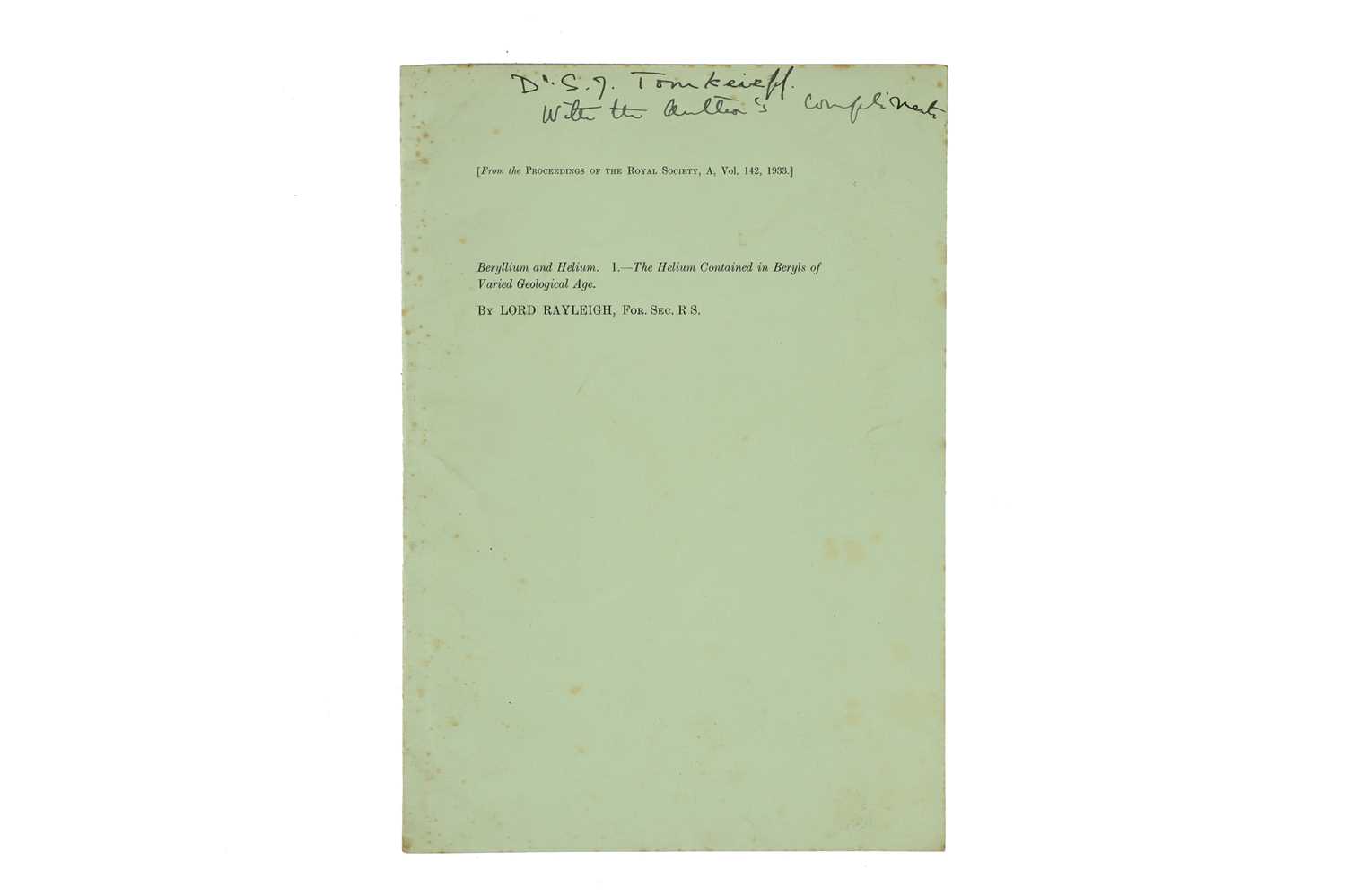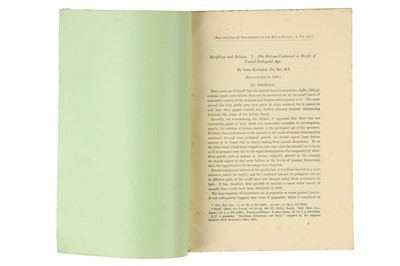24th Nov, 2022 11:00
Fine Scientific & Medical Instruments and Books
Lord Rayleigh, Beryllium and Helium
offprint from the Proceedings of the Royal Society, A, Vol. 142, 1933, Beryllium and Helium. I. - The Helium Contained in Beryls of Varied Geological Age, signed in pen to the front cover P.S.I. Tomkeieff, with the author's compliments
John William Strutt, 3rd Baron Rayleigh (1842-1919), a mathematician and physicist, won the 1904 Nobel Prize in physics for his work on gases and the subsequent discovery of Argon. Not just confined to research on gases, Lord Rayleigh also contributed to our understanding of how light is affected by particles that are smaller than the light’s wavelength. This phenomenon, known as Rayleigh scattering, explains why the daytime sky is blue. Additionally, he contributed to the study of fluid dynamics, aerodynamics and quantum theory. Even today Lord Rayleigh’s 1877 text, The Theory of Sound, is used by sound engineers. Lord Rayleigh conducted the entirety of his academic career at the University of Cambridge, where he was chancellor in his twilight years from 1908-1919.
Professor Sergei Ivanovich Tomkeieff FRSE FGS (1892–1968) was a 20th-century Lithuanian geologist and petrologist. He was born on 20 October 1892 in Vilna the capital of Lithuania. He came to Britain either during or just after the First World War and began lecturing in Geology at Anderson College in Newcastle-upon-Tyne in 1920.
In 1948 he was elected a Fellow of the Royal Society of Edinburgh. His proposers were Arthur Holmes, James Ernest Richey, Sir Edward Battersby Bailey, Heslop Harrison, George Walter Tyrrell, John Weir, and H. B. Donald. In 1957 he became Professor of Petrology at the Anderson College.
He was Author of many books including; The Tholeite Dyke at Cowgate (1953); Coals, Bitumens and other Related Fossil Carbonaceous Substances (1954); Isle of Arran (1961); The Economic Geology of Quarried Materials (1969) Dictionary of Petrology (1983) (posthumous). He was awarded the Geological Society's Lyell Medal in 1966. He died on 27 October 1968 in Newcastle aged 76
offprint from the Proceedings of the Royal Society, A, Vol. 142, 1933, Beryllium and Helium. I. - The Helium Contained in Beryls of Varied Geological Age, signed in pen to the front cover P.S.I. Tomkeieff, with the author's compliments
John William Strutt, 3rd Baron Rayleigh (1842-1919), a mathematician and physicist, won the 1904 Nobel Prize in physics for his work on gases and the subsequent discovery of Argon. Not just confined to research on gases, Lord Rayleigh also contributed to our understanding of how light is affected by particles that are smaller than the light’s wavelength. This phenomenon, known as Rayleigh scattering, explains why the daytime sky is blue. Additionally, he contributed to the study of fluid dynamics, aerodynamics and quantum theory. Even today Lord Rayleigh’s 1877 text, The Theory of Sound, is used by sound engineers. Lord Rayleigh conducted the entirety of his academic career at the University of Cambridge, where he was chancellor in his twilight years from 1908-1919.
Professor Sergei Ivanovich Tomkeieff FRSE FGS (1892–1968) was a 20th-century Lithuanian geologist and petrologist. He was born on 20 October 1892 in Vilna the capital of Lithuania. He came to Britain either during or just after the First World War and began lecturing in Geology at Anderson College in Newcastle-upon-Tyne in 1920.
In 1948 he was elected a Fellow of the Royal Society of Edinburgh. His proposers were Arthur Holmes, James Ernest Richey, Sir Edward Battersby Bailey, Heslop Harrison, George Walter Tyrrell, John Weir, and H. B. Donald. In 1957 he became Professor of Petrology at the Anderson College.
He was Author of many books including; The Tholeite Dyke at Cowgate (1953); Coals, Bitumens and other Related Fossil Carbonaceous Substances (1954); Isle of Arran (1961); The Economic Geology of Quarried Materials (1969) Dictionary of Petrology (1983) (posthumous). He was awarded the Geological Society's Lyell Medal in 1966. He died on 27 October 1968 in Newcastle aged 76
Auction: Fine Scientific & Medical Instruments and Books, 24th Nov, 2022



